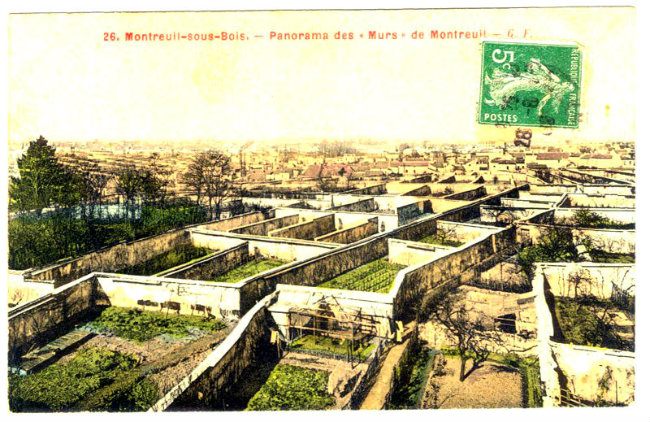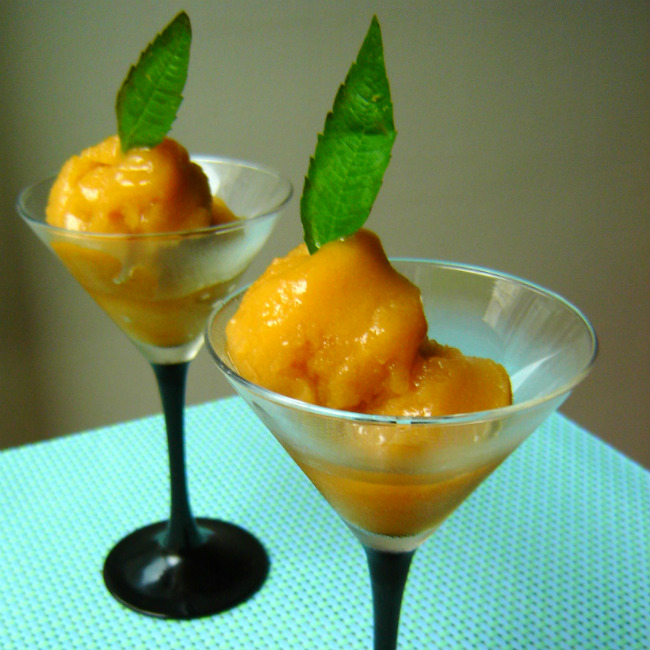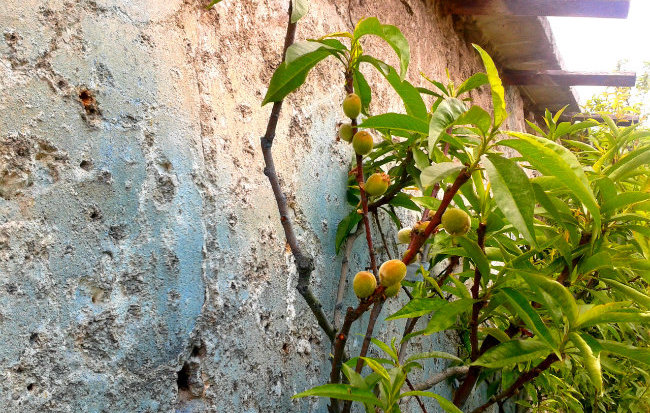The Peach Walls of Paris & A Recipe for Peach and Lemon Verbena Sorbet
With the heat of summer, I crave the sweetly perfumed white-fleshed peaches that arrive at the markets in Paris from the south of France. But nearly 150 years ago, Parisians stocked up on peaches that came from right here in Paris, or at least, in the neighboring suburb of Montreuil.
The Montreuil peach walls, or murs à pêches, date from the 15th, 16th, or 17th centuries, depending on who you talk to. One thing is sure: peaches have been cultivated in France since the Middle Ages, when they were first imported from China.
The Montreuil peach orchards supplied the royal appetites of the court at nearby Château de Vincennes, and just like Champagne, this royal association earned the peaches instant popularity. Louis XIV was also a fan, and he grew 33 peach varieties of his own at Versailles, including the Téton de Vénus, or Venus’ Nipple. (With such a titillating name, it’s hardly surprising that variety was so popular.)

A postcard showing the Montreuil peach walls. Photo: © Fédération des Murs à Pêches
After the French Revolution, the production of peaches in Montreuil really took off, and even the Queen of England and Russian czars were importing peaches from Montreuil. The abolition of feudal privileges and the sale of clerical lands after the Revolution meant that by 1880, about 600 kilometers of walls were being used to grow 17 million peaches. In fact, there were so many peaches that the town’s official name, Montreuil-sous-Bois, was transformed into the nickname Montreuil-aux-Pêches!
To adapt the fruit to cold northern temperatures, the peach-growing method used in Montreuil was unique. Orchards featured walls covered in white plaster, and the thick walls were built in a north-south direction, so direct morning and afternoon sun would heat each side of the wall. At night, the walls gave off this accumulated heat, creating a micro-climate in which the delicate peaches were protected from the cold and could ripen. Pretty smart, those Montreuillois!
But the Industrial Revolution spelled the end of peach production in Montreuil. By the late 1800s, the Paris-Lyon-Marseille train line was hauling peaches from the south to the central Les Halles market much earlier in the season, at a cheaper price, and suddenly the Montreuil peaches became an anachronism.

A peach wall, soon to be restored. Photo: Allison Zinder
The peach walls are still there, even though many are in a state of ruin. 34 hectares (84 acres) make up a funny little area of Montreuil located near the impasse Gobetue, between a cemetery and a couple of badly-paved streets, complete with caravans and stray cats. These streets are the stomping ground of a handful of gens du voyage or Roma/Romani people.
Garnering support for the renovation and maintenance of the peach walls isn’t easy, but the annual Peach Wall Festival regularly attracts over 3000 visitors. Last time I was there with some friends, we wandered among the white walls, covered with espaliered peach trees and their fruit. Flowers grew everyplace in between: they harken back to when peach growers also cultivated irises, lilacs, peonies, grapes, and raspberries to earn extra income. In fact, there was even a special pavilion at Les Halles market dedicated to products from Montreuil!

Irises and other flowers flourish between the peaches. Photo: Allison Zinder
Nowadays, several organizations, like the Peach Wall Federation, are working hard to preserve the site from threats of destruction by property developers and other urbanization plans. The Federation also raises awareness in a charming and fun way: the Peach Wall Festival features land art, marionette shows for kids, food stands, and enough musical activities to rock those peach walls!
The Montreuil peach walls are open to the public on Sundays from 2:30 pm to 4:30 pm. The closest metro is Mairie de Montreuil, and then it’s a good hike to the end of the impasse Gobetue where you can enter the walled gardens.
Many thanks go to François Poupeau whose article was very helpful in researching this one.
Click here for a recent article (in French) from Le Parisien, or here for an article from France Today.
Peach and Lemon Verbena Sorbet
Peaches and lemon verbena make for a delightfully light, fresh combination, perfect for the dog days of August. If you have a garden, it’s worth growing some fresh lemon verbena in a sunny place near a door. Every time you brush past the plant’s leaves, they’ll fill the air with their lemony fragrance.

Peach and lemon verbena sorbet. Photo: Allison Zinder
If you can’t find any fresh lemon verbena, no worries: you can use dried leaves. If you’re not in France, you can order them, or here in Paris, you can find them in pharmacies or at the Herboristerie du Palais Royal. Many people in France keep lemon verbena leaves on hand to make a refreshing after-dinner infusion, or herbal tea, since it’s a fantastic digestion aid, and even acts as a mild sedative, perfect for sending your dinner guests home ready for bed!
ingredients:
¾ cup (150g) sugar
½ cup + ⅛ cup (150ml) water
2 9-inch (23cm) branches fresh lemon verbena, washed, or 2 handfuls dried lemon verbena leaves
about 1 pound, 8 ounces (700g) fresh, ripe peaches, washed well
special equipment: electric or hand-crank ice-cream maker
how to make it:
- The day before you plan on making the sorbet, if you’re using an electric ice-cream maker, place the bowl in the freezer.
- Combine the sugar and the water in a small casserole, and heat just to boiling over medium heat. Stirring well, boil for about 3-4 minutes, or until the sugar is fully dissolved.
- Pick out 6 of the prettiest verbena leaves for the decor, and reserve in the refrigerator.
- Add the remaining lemon verbena leaves to the syrup and push them down with a spoon, making sure they are fully submerged in the syrup. Cover the casserole and let the leaves infuse for 20 minutes.
- In the meantime, cut the peaches in half and remove the pits. Then cut them again into quarters. Using a wand mixer or a blender, purée the peaches well. (You should end up with about 4½ cups (1115g) of purée.)
- Strain the peach purée through a fine-mesh strainer. You’ll have to stir and press quite a bit to force the purée through, and you’ll be left with bits of peach skin, which you can discard.
- Remove the verbena leaves from the syrup, scraping off as much syrup as you can, and discard the leaves. Add the infused syrup to the peach purée, stir well, and refrigerate, covered, for 2-4 hours.
- When you’re ready to make the sorbet, pour the purée into the ice-cream maker and churn according to the manufacturer’s instructions.
- Once the mixture is done churning, it will be homogenous but still very soft and slightly slushy. This is normal, because there’s a lower sugar content in this sorbet than in many. (I like desserts with a little less sugar.) Transfer the sorbet into a freezer-proof container and freeze for about ½ hour.
- Serve in small bowls or in sorbet coupes and decorate with the verbena leaves. Bon app’!
makes a scant liter of sorbet, or about 6 servings

Peach and lemon verbena sorbet. Photo: Allison Zinder
Lead photo credit : The warm plaster of the walls creates a microclimate for the peaches to grow. Photo: Allison Zinder




